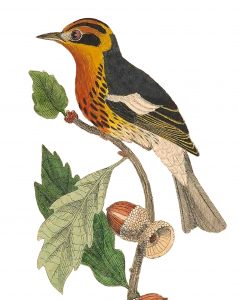
As spring turns to summer, the woods of Historic Mill Creek are alive with birdsong. By mid-June, year-round residents of the park, such as black-capped chickadees, nuthatches, and tufted titmice, have been singing since winter snow gave way to spring wildflowers. Summer residents, many which migrated north for thousands of miles, arrive “finely tuned” and ready to put on a show as they attract mates and defend nesting territories.
The official wildlife checklist of Mill Creek includes about 130 species of birds, while the list for Mackinac Island contains 190 varieties. Both parks consist of varied habitats, including Lake Huron shoreline, creeks and streams, swamps, open meadows, and forests of conifers and hardwoods.
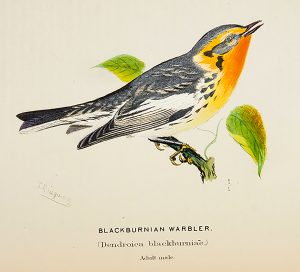
Finding birds at Mill Creek begins as soon as you step out of your car. Although the tree canopy is filled with green, listen closely for musical notes floating in the breeze. In the pines growing near the visitor’s center, you may hear a “shrill, thin song, which runs up the scale to end in a high z.” If so, pause and search for a blackburnian warbler hunting for insects among the branches. Catching a glimpse of a male’s flame-orange throat may just take your breath away! As they prefer evergreens for nesting, this species was once known as the “hemlock warbler.”
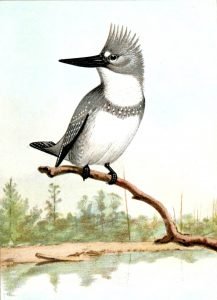
Stop for a trail map as you make your way into the park. Next, follow the sound of rushing water and you’ll soon discover Mill Creek. Sitting near the mill pond, patient watchers may enjoy a visit from a belted kingfisher as it scans for brook trout. Kingfishers are memorable birds, with a dry, rattling call that announces their presence long before they fly into view. Unlike most birds, female kingfishers are more colorful than males, as they wear a chestnut-brown “necklace” while their mate sports a simple bluish band across their chest.
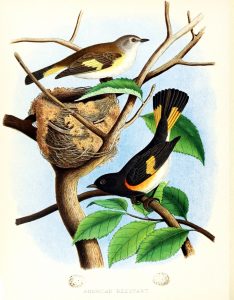
As you head into the woods, it’s nearly impossible to avoid an encounter with an American redstart. In 1893, Mackinac Island resident and researcher, Stewart E. White, wrote this was “the most characteristic bird of the island. It occurs in such amazing abundance that it seems as if every tree contained one of these birds.” Thankfully, such words still ring true today as this flashy black, orange and white warbler is still one of our most common summer residents. Plumage of females and immature males consists of light brown tones with yellow highlights.
Relentlessly persistent, a restart’s repetitive, mellow song begins as soon as they arrive in May and lasts through August. This woodland songster sings for weeks on end, seemingly, as one early 20th century author noted, “to the accompaniment of his own echo.”
As you continue down the trail, the species of birds you may encounter numbers in the dozens. Almost assuredly, you’ll hear the insistent, rambling song of the red-eyed vireo, the plaintive “peee-weee” call of the eastern wood peewee, and the rapid staccato of “teacher-teacher-TEACHER” from the tiny ovenbird, ringing through the forest. Venture out in the morning or evening for a chance to hear the ethereal, flute-like call of a wood thrush, perhaps the most magical song of the North Woods.
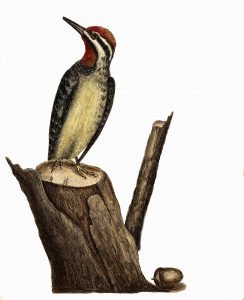
If you don’t encounter one of our six resident woodpecker species, you’re almost certain to find evidence of their handiwork, hammering trees for insects beneath the bark. Especially watch for huge, rectangular cavities excavated by the crow-sized pileated woodpecker and small, regular rows of “sap wells” chiseled by yellow-bellied sapsuckers. Sapsuckers maintain wells to drink sap that drips out, but more importantly to capture insects that become trapped in sweet liquid that seeps from the tree. Sap wells in dead wood are evidence of a previous season’s efforts.
No matter where you wander, watch and listen for birds all around you, each of which varies in color, shape, song, size, habits and habitats. Ancestors of many special species found homes in the forest of Historic Mill Creek long before people arrived on the scene. While some are suited to the creek or frequent the shore of a beaver pond, others prefer poking through leaf-litter on the forest floor. Some nearly never leave the tree canopy high above, while others may zip past you on their way to pick a sunflower seed from a bird feeder.
During your visit, be sure to sit and scan the summer sky. Every day, someone spots a bald eagle floating effortlessly on the wind, high above the forest canopy. As you watch an eagle soar, consider it may also be watching you, with eyesight sharper than its talons. As it finally leaves your view, let your imagination follow into the unknown. At Historic Mill Creek, the feathered residents of Mackinac’s North Woods are waiting. Here you’ll discover ducks on the mill pond, friendly chickadees at the feeder, tiny hummingbirds sipping nectar, and the majestic symbol of our nation soaring over the Great Lakes. We all hope to see you soon.









